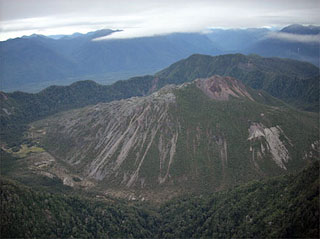Report on Chaiten (Chile) — 23 July-29 July 2008
Smithsonian Institution / US Geological Survey
Weekly Volcanic Activity Report, 23 July-29 July 2008
Managing Editor: Sally Sennert.
Please cite this report as:
Global Volcanism Program, 2008. Report on Chaiten (Chile) (Sennert, S, ed.). Weekly Volcanic Activity Report, 23 July-29 July 2008. Smithsonian Institution and US Geological Survey.
Chaiten
Chile
42.8349°S, 72.6514°W; summit elev. 1122 m
All times are local (unless otherwise noted)
SERNAGEOMIN reported that clouds obscured camera views of Chaitén's eruption plume on 21 and 22 July. The E-drifting eruption plume was weaker when observed on 23 July and only rose to an altitude of less than 2 km (6,600 ft) a.s.l. In contrast, during 21-23 July earthquakes greater than M 2.6 increased in number and magnitude. The Alert Level was raised to Volcanic Alert Red Level 6.
An overflight on 24 July revealed a plume that rose to an altitude of 2 km (6,600 ft) a.s.l. It vented from an area S of a previous emission point, on the S flank of the new lava dome. The plume intermingled with other plumes generated by explosions. A gas-and-steam plume was emitted from a depression, also on the S flank, that was possibly formed by an explosion or partial collapse the previous day or two. Gas-and-steam plumes were emitted from the base of the E flank. On 24 July, ashfall near the city of Chaitén was about 3 cm thick. During 24-29 July, clouds generally prevented visual observations; occasionally the plume was visible and rose to an altitude of 2 km (6,600 ft) a.s.l. On 27 July, ashfall was again reported in the city of Chaitén.
Geological Summary. Chaitén is a small caldera (~3 km in diameter) located 10 km NE of the town of Chaitén on the Gulf of Corcovado. Multiple explosive eruptions throughout the Holocene have been identified. A rhyolitic obsidian lava dome occupies much of the caldera floor. Obsidian cobbles from this dome found in the Blanco River are the source of artifacts from archaeological sites along the Pacific coast as far as 400 km from the volcano to the N and S. The caldera is breached on the SW side by a river that drains to the bay of Chaitén. The first recorded eruption, beginning in 2008, produced major rhyolitic explosive activity and building a new dome and tephra cone on the older rhyolite dome.
Source: Servicio Nacional de Geología y Minería (SERNAGEOMIN)

